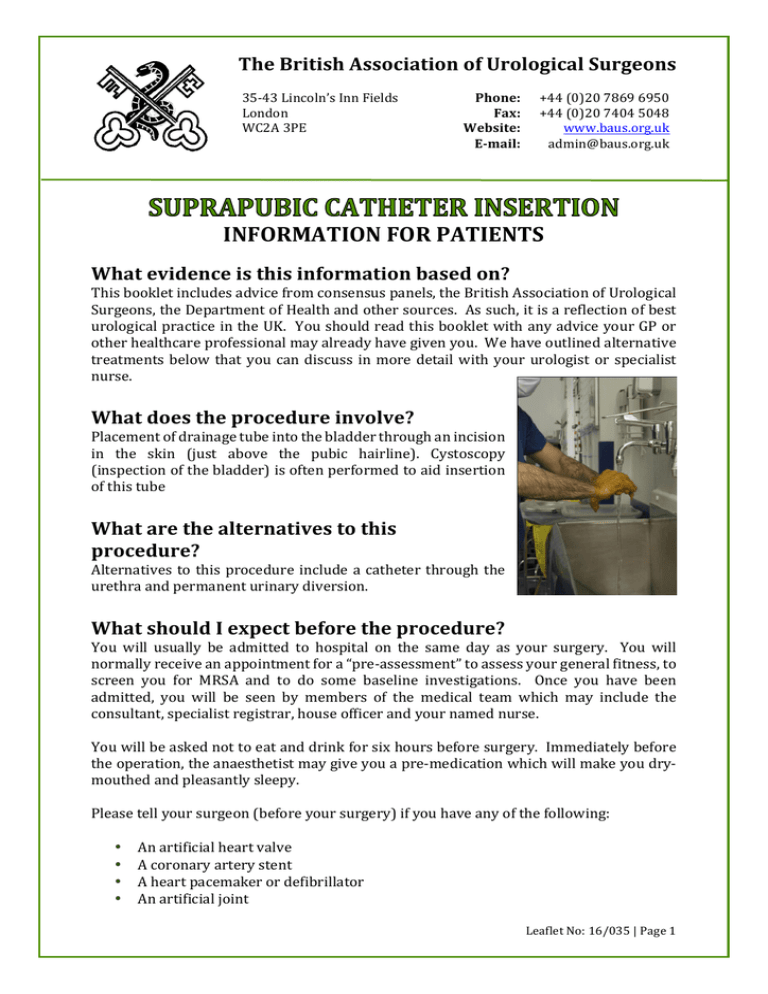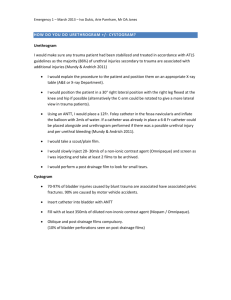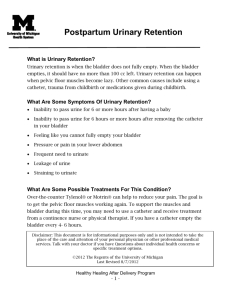Document 12497368
advertisement

The British Association of Urological Surgeons 35-­‐‑43 Lincoln’s Inn Fields London WC2A 3PE Phone: Fax: Website: E-­‐‑mail: +44 (0)20 7869 6950 +44 (0)20 7404 5048 www.baus.org.uk admin@baus.org.uk INFORMATION FOR PATIENTS What evidence is this information based on? This booklet includes advice from consensus panels, the British Association of Urological Surgeons, the Department of Health and other sources. As such, it is a reflection of best urological practice in the UK. You should read this booklet with any advice your GP or other healthcare professional may already have given you. We have outlined alternative treatments below that you can discuss in more detail with your urologist or specialist nurse. What does the procedure involve? Placement of drainage tube into the bladder through an incision in the skin (just above the pubic hairline). Cystoscopy (inspection of the bladder) is often performed to aid insertion of this tube What are the alternatives to this procedure? Alternatives to this procedure include a catheter through the urethra and permanent urinary diversion. What should I expect before the procedure? You will usually be admitted to hospital on the same day as your surgery. You will normally receive an appointment for a “pre-­‐‑assessment” to assess your general fitness, to screen you for MRSA and to do some baseline investigations. Once you have been admitted, you will be seen by members of the medical team which may include the consultant, specialist registrar, house officer and your named nurse. You will be asked not to eat and drink for six hours before surgery. Immediately before the operation, the anaesthetist may give you a pre-­‐‑medication which will make you dry-­‐‑ mouthed and pleasantly sleepy. Please tell your surgeon (before your surgery) if you have any of the following: • An artificial heart valve • A coronary artery stent • A heart pacemaker or defibrillator • An artificial joint Leaflet No: 16/035 | Page 1 • • • • • • An artificial blood-­‐‑vessel graft A neurosurgical shunt Any other implanted foreign body A regular prescription for a blood thinning agent such as warfarin, aspirin, clopidogrel (Plavix®), rivaroxaban, prasugrel or dabigatran A previous or current MRSA infection A high risk of variant-­‐‑CJD (if you have had a corneal transplant, a neurosurgical dural transplant or injections of human-­‐‑derived growth hormone). When you are admitted to hospital, you will be asked to sign the second part of your operation consent form giving permission for your operation to take place, showing you understand what is to be done and confirming that you want to go ahead. Make sure that you are given the opportunity to discuss any concerns and to ask any questions you may still have before signing the form. What happens during the procedure? Either a full general anaesthetic (where you will be asleep) or a spinal anaesthetic (where you are unable to feel anything from the waist down) will be used. All methods reduce the level of pain afterwards. Your anaesthetist will explain the pros and cons of each type of anaesthetic to you. You will usually be given injectable antibiotics before the procedure, after checking for any allergies. The surgeon will first fill your bladder with fluid and then insert the catheter through a small incision in your lower tummy (pictured), just above the pubic hairline. In patients with small bladders, the incision may need to be larger so that the bladder can be seen clearly, allowing the catheter to be inserted safely. Correct positioning within the bladder is checked by telescopic inspection of the bladder via the water pipe (urethra). What happens immediately after the procedure? You should be told how the procedure went and you should: • • • • • ask the surgeon if it went as planned; let the medical staff know if you are in any discomfort; ask what you can and cannot do; feel free to ask any questions or discuss any concerns with the ward staff and members of the surgical team; and make sure that you are clear about what has been done and what happens next. SUPRAPUBIC CATHETER INSERTION Leaflet No: 16/035 | Page 2 The catheter may be stitched in place at first, but these stitches can be removed after a week or so, without the catheter falling out. The average hospital stay is two days. Are there any side-­‐‑effects? Most procedures have possible side-­‐‑effects. But, although the complications listed below are well-­‐‑recognised, most patients do not suffer any problems. Common (greater than 1 in 10) • Temporary mild burning or bleeding during urination. Occasional (between 1 in 10 and 1 in 50) • Infection of the bladder needing antibiotics (occasionally, recurrent infections). • Blocking of the catheter needing unblocking. • Bladder discomfort and pain. • Persistent leakage from the water pipe (urethra) which may need a further operation to close the bladder neck. • Development of stones and debris in the bladder, causing catheter blockage, and requiring removal or crushing by a further procedure. Rare (less than 1 in 50) • Bleeding requiring irrigation, or additional catheterisation, to remove blood clot. • Rarely, damage to surrounding structures, such as bowel or blood vessels with serious consequences, possibly needing additional surgery. Hospital-­‐‑acquired infection • Colonisation with MRSA (0.9% -­‐‑ 1 in 110). • MRSA bloodstream infection (0.02% -­‐‑ 1 in 5000). • Clostridium difficile bowel infection (0.01% -­‐‑ 1 in 10,000). Please note: The rates for hospital-­‐‑acquired infection may be greater in “high-­‐‑risk” patients. This group includes, for example, patients with long-­‐‑term drainage tubes, patients who have had their bladder removed due to cancer, patients who have had a long stay in hospital or patients who have been admitted to hospital many times. What should I expect when I get home? When you are discharged from hospital, you should: • be given advice about your recovery at home; • ask when you can begin normal activities again, such as work, exercise, driving, housework and sex; • ask for a contact number if you have any concerns once you return home; • ask when your follow-­‐‑up will be and who will do this (the hospital or your GP); and SUPRAPUBIC CATHETER INSERTION Leaflet No: 16/035 | Page 3 • be sure that you know when you get the results of any tests done on tissues or organs that have been removed. When you leave hospital, you will be given a “draft” discharge summary. This contains important information about your stay in hospital and your operation. If you need to call your GP or if you need to go to another hospital, please take this summary with you so the staff can see the details of your treatment. This is important if you need to consult another doctor within a few days of being discharged. When you get home, you should drink twice as much fluid as you would normally for the first 24 to 48 hours. This helps to flush your system through and minimises any bleeding. The catheter will need to be changed, for the first time, after approximately six weeks and we will arrange this for you in the outpatient clinic. Thereafter, further catheter changes can be performed by your GP or district nurse. What else should I look out for? If you develop a fever, redness in the wound, any pus from the catheter site or worsening bleeding, you should contact your GP immediately. In the event of the catheter falling out, it must be replaced as a matter of urgency or the track will close up and it may not be possible to re-­‐‑insert it. Contact your GP for immediate advice or come directly to your local Accident & Emergency Department. Are there any other important points? Some discharge from the catheter site is not unusual in the longer term. If the catheter blocks within the first four weeks, the channel between the skin and the bladder will not have healed completely so it is not possible to change the catheter easily. In this event, it is important that the catheter is not taken out in an attempt to change it. It should simply be left in place and an urethral catheter inserted as well, followed by immediate notification of the urology specialist nurse. Driving after surgery It is your responsibility to make sure you are fit to drive following your surgery. You do not normally need to tell the DVLA that you have had surgery, unless you have a medical condition that will last for longer than three months after your surgery and may affect your ability to drive. You should, however, check with your insurance company before returning to driving. Your doctors will be happy to give you advice on this. Is any research being carried out in this area? Before your operation, your surgeon or specialist nurse will tell you about any relevant research studies taking place. In particular, they will tell you if any tissue that is removed during your surgery will be stored for future study. If you agree to this research, you will be asked to sign a special form giving your consent. SUPRAPUBIC CATHETER INSERTION Leaflet No: 16/035 | Page 4 All surgical procedures, even those not currently undergoing research, are audited so that we can analyse our results and compare them with those of other surgeons. In this way, we learn how to improve our techniques and results; this means that our patients will then get the best treatment available. What should I do with this information? Thank you for taking the trouble to read this booklet. If you want to keep a copy for your own records, please sign below. If you would like a copy of this booklet filed in your hospital records for future reference, please let your urologist or specialist nurse know. However, if you do agree to go ahead with the scheduled procedure, you will be asked to sign a separate consent form that will be filed in your hospital records; we can give you a copy of this consent form if you ask. I have read this booklet and I accept the information it provides. Signature............................................................... Date........................................... SUPRAPUBIC CATHETER INSERTION Leaflet No: 16/035 | Page 5 How can I get information in alternative formats? Please ask your local NHS Trust or PALS network if you require this information in other languages, large print, Braille or audio format. Most hospitals are smoke-­‐‑free. Smoking can make some urological conditions worse and increases the risk of complications after surgery. For advice on stopping, contact your GP or the free NHS Smoking Helpline on 0800 169 0 169 Disclaimer While we have made every effort to be sure the information in this booklet is accurate, we cannot guarantee there are no errors or omissions. We cannot accept responsibility for any loss resulting from something that anyone has, or has not, done as a result of the information in this booklet. The NHS Constitution Patients’ Rights & Responsibilities Following extensive discussions with staff and the public, the NHS Constitution has set out new rights for patients that will help improve your experience within the NHS. These rights include: • a right to choice and a right to information that will help you make that choice; • a right to drugs and treatments approved by NICE when it is considered clinically appropriate; • a right to certain services such as an NHS dentist and access to recommended vaccinations; • the right that any official complaint will be properly and efficiently investigated, and that patients will be told the outcome of the investigations; and • the right to compensation and an apology if you have been harmed by poor treatment. The constitution also lists patients’ responsibilities, including: • providing accurate information about their health; • taking positive action to keep yourself and your family healthy. • trying to keep appointments; • treating NHS staff and other patients with respect; • following the course of treatment that you are given; and • giving feedback (both positive and negative) after treatment. © British Association of Urological Surgeons (BAUS) Limited Published: March 2016. Due for review: March 2018 SUPRAPUBIC CATHETER INSERTION Leaflet No: 16/035 | Page 6







